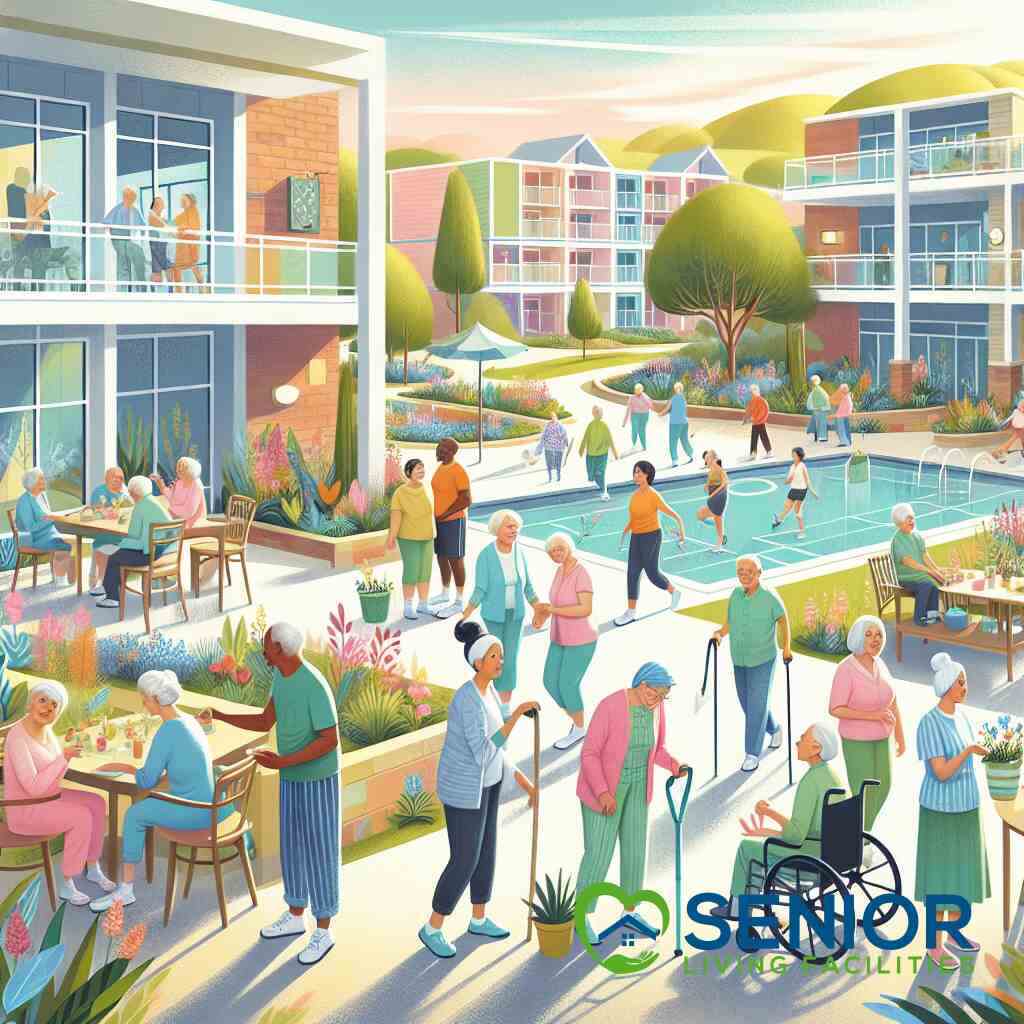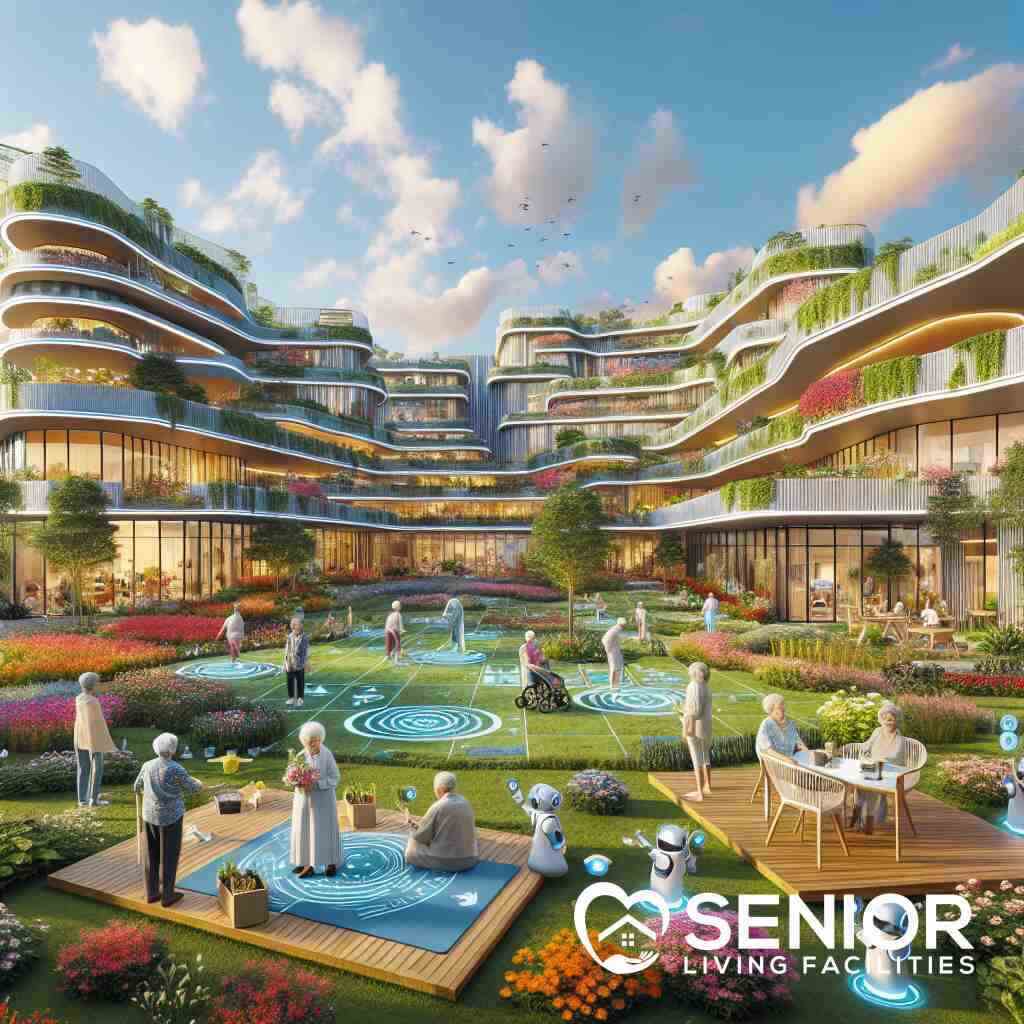
How to Navigate Senior Living Facilities for Best Choice? Ultimate Guide to In-Depth Senior Living Choices
January 13, 2025
Embarking on the Journey of Senior Living
Understanding the Spectrum of Senior Living Facilities
Navigating senior living options can initially seem overwhelming due to the wide variety of facilities available. To make an informed decision, it’s crucial to have a comprehensive understanding of these options. Senior living facilities encompass independent living, assisted living, nursing homes, and more specialized setups like memory care units. Each type of community presents unique features tailored to the resident’s needs, from medical care to social engagements. Familiarize yourself with understanding senior living to identify what aligns best with the habits and health requirements of the potential resident.
Recognizing the Need for Transition
Deciding when it’s time to transition into a senior living facility can be a sensitive and complex decision. Recognizing signs indicating a need for more structured support or specialized care is essential. These signs might include increased difficulty in managing daily tasks, requiring assistance for mobility, or a need for more intensive medical supervision. It’s vital to involve the individual in these discussions early, ensuring that they feel empowered and supported during this life change. Regular family dialogues and open discussions about future living preferences can prevent hasty decisions and ensure smoother transitions.
Initial Steps in the Decision-Making Process
The decision-making process for choosing a senior living facility begins with assessing immediate care needs and lifestyle preferences. Considerations for The Ultimate Guide to In-Depth Senior Living Choices can provide a comprehensive understanding of what might fit best. Begin by gathering information about various communities and what they offer in terms of care levels, social activities, and location benefits. Once you have a broad understanding, visit potential facilities to experience the environment firsthand. Online resources can be immensely helpful; for example, you can explore the variety of senior living options near you to find communities that closely match your criteria. Engaging with professionals and utilizing platforms like Senior Living Facilities can significantly narrow your choices, ensuring you’re equipped to make the best decision.
Decoding Senior Living Options
Navigating Independent Living vs. Assisted Living
When considering senior living options, understanding the distinctions between independent living and assisted living is crucial. Independent living communities cater to seniors who seek a vibrant social lifestyle but with minimal assistance in daily activities. These communities often feature private apartments and communal amenities, promoting autonomy and social engagement. On the other hand, assisted living facilities offer a combination of independence and support services. They are designed for seniors requiring help with activities of daily living in senior care, such as bathing or managing medication, while still valuing their privacy and independence. To appreciate these differences fully, it’s essential to weigh the level of assistance needed against the desire for social interaction and autonomy.
Choosing between these options requires evaluating several factors, such as current health status and future care needs, as outlined in How Senior Living Facilities Overhaul Daily Life in 2024?. Thoroughly assessing these elements ensures that the selected senior living community aligns with the lifestyle preferences and medical requirements of the individual. It is advantageous to consider transitioning options t, oo. Some facilities offer step-up programs, which allow seamless movement from independent to assisted living as needs evolve. Engaging with understanding nuances of assisted living can provide deeper insights into the tailored services available, facilitating more informed decisions.
Evaluating Residential Care Homes and Nursing Homes
Residential care homes and nursing homes represent another layer of senior living options, offering different levels of care and community environments. Residential care homes, often smaller in size, provide a more homelike atmosphere where personalized care and daily assistance can be more concentrated. This setting is ideal for seniors who prefer intimate settings and need moderate assistance with daily activities. Nursing homes, conversely, cater to individuals requiring extensive medical care and constant supervision, often by a team of healthcare professionals. They are best suited for residents with severe health conditions or post-operative care needs, focusing on medical intervention and rehabilitation.
Evaluating these options involves considering medical needs and personal preferences regarding living environments. Touring both types of facilities can help ascertain which best aligns with the required level of care and lifestyle desires. FUnderstandingstaff qualifications, resident programs, and health services offered is crucial for comprehensive nursing home insights. Additionally, consulting with healthcare providers can further assist in recommending the appropriate environment for ongoing medical and personal care requirements, ensuring the setting chosen provides optimal support and comfort.
Understanding In-Home Care Opportunities
In-home care presents another viable option for seniors who wish to remain in familiar surroundings while still receiving necessary assistance. This option is particularly suitable for those who value their independence and prefer to avoid the communal living environment of residential facilities. In-home care services range from medical support to assistance with personal tasks like navigation through daily routines or transportation. This type of care can be tailored to the unique needs of the individual, often incorporating various elements as health conditions change.
The flexible nature of in-home care makes it an attractive alternative for many. However, choosing this option requires careful planning regarding hiring qualified caregivers and ensuring that the level of assistance provided can adequately meet both current and anticipated future needs. It is essential to recognize when in-home care may need to transition to more comprehensive support, such as assisted living or nursing care. Exploring the dynamics of in-home care can lead to a satisfying balance between maintaining independence and ensuring sufficient support is available to lead a qualitatively rich life at an advanced age.
Crucial Factors in Selecting the Optimal Facility
Assessing Care Needs and Lifestyle Preferences
Understanding the unique care needs and lifestyle preferences of seniors is imperative in selecting an optimal senior living facility, as discussed in Exploring Senior Living Options in Your State for 2024. Begin by assessing the level of care needed, such as help with daily activities or more intensive medical supervision. Preferences regarding social interactions, hobbies, and dining options should also be considered. This comprehensive evaluation ensures that the chosen community not only meets health requirements but also aligns with personal lifestyle desires. Engaging with resources like the independent living guide can provide insights into options available for maintaining autonomy while receiving necessary care.
Location, Accessibility, and Community Amenities
The location of a senior living facility plays a significant role in ensuring convenience and accessibility for both seniors and their families. Proximity to medical centers, family members, and familiar surroundings can enhance the comfort and well-being of residents. Moreover, communities tailored for seniors aged 55+ often provide a range of amenities like gardens, fitness centers, and social clubs, which are crucial for fostering engagement and wellness. Evaluating amenities such as transportation services, meal plans, and on-site recreational activities strengthens decision-making, supporting informed choices in the present and future.
Financial Planning: Budgeting for Long-term Care
Effective financial planning is essential when selecting a senior living facility due to the potentially significant long-term costs associated with care. Begin by evaluating available financial resources, insurance policies, and potential government aid programs designed to aid seniors. Understanding the full spectrum of costs, including entrance fees, monthly charges, and additional costs for specialized services, is critical. It’s advisable to consider the projected costs over several years, accounting for potential increases due to inflation and evolving care needs. With a comprehensive financial strategy in place, families can confidently navigate retirement community selections and ensure sustainable elder care solutions.
Mastering the Art of Comparison
Utilizing Online Tools and Resources for Evaluation
Leveraging online resources is paramount to navigating senior living facilities effectively. The digital landscape today offers various tools that allow individuals to compare retirement community selection options with ease. Platforms like Senior Living Facilities provide comprehensive insights into different types of senior residences, assisting in evaluating senior facilities comprehensively. By using these resources, families can identify facilities that align with both immediate needs and long-term care objectives. This approach ensures a broadened perspective on various senior lifestyle solutions tailored to unique requirements.
Furthermore, these platforms offer features to assess communities based on levels of care, cost structures, and amenities, ensuring a well-rounded evaluation. Engaging with online platforms helps demystify the complexities involved in retirement community evaluations and promises a more seamless process. Understanding how to navigate senior living facilities in the modern era empowers individuals to make decisions grounded in knowledge rather than conjecture.
Importance of Visiting Potential Facilities
While digital tools provide an excellent foundation, visiting potential senior living facilities is imperative for accurate retirement care evaluation. Physical tours allow families and seniors to experience the ambiance, assess the living conditions, and interact with staff and residents. These visits are crucial in determining whether the environment aligns with personal preferences and care needs, ensuring the prospective community feels at home.
During these visits, attention should be paid to how staff engage with residents, the cleanliness of the facility, and the overall quality of community life. Reading the Ultimate Review: Senior Living Facilities Across America could offer further guidance. Observing these elements in person can reveal nuances that online descriptions may omit. This tangible experience serves as an invaluable component in the retirement home comparison process, providing peace of mind through firsthand insight into potential senior residences.
Consulting with Experts for Informed Decisions
In conjunction with online resources and facility visits, consulting with industry experts offers an added layer of assurance. These professionals provide elder care guidance, help decode complex information, and offer personalized recommendations. By engaging with experts, families can ensure the senior housing decision is well-informed and reflective of the individual’s health, lifestyle, and financial parameters.
Expert consultations offer tailored insights, benefiting families by addressing specific queries or concerns. They can also illuminate lesser-known factors influencing senior care planning, such as insurance benefits and regional care quality variations. Whether you’re looking at contacting senior living consultation or exploring communities through local specialists, expert advice enhances the decision-making process, facilitating a smooth and confident transition into the chosen senior living community.
Connecting with Your Chosen Community
Integrating Into a New Environment
Navigating the transition into a new senior living facility is pivotal for a resident’s sense of belonging and comfort. The key is to foster a welcoming atmosphere that encourages engagement with the community’s rhythm and life. Seniors should start by familiarizing themselves with the facility’s layout, resources, and daily routines. This proactive approach can ease the anxiety associated with change. Participating in orientations and introductory meetings can also offer valuable insights, helping newcomers understand what defines quality communities in senior living. And how they can make the most of their new environment. Developing a routine that integrates personal interests and facility offerings enhances this transition, creating a foundation for satisfaction and stability in the chosen senior residence.
Establishing strong communication lines with staff is equally important. A transparent relationship between caregivers and management builds trust and ensures any concerns or preferences are addressed promptly. Personalized relationships with the caregiving team can enhance a sense of home, significantly contributing to quality of life. It is beneficial to tap into the facility’s communication portals or platforms, which facilitate easy interaction with staff and fellow residents, promoting a cohesive community dynamic.
Building Social Connections and Activities Engagement
Establishing social connections within a senior living community greatly enhances the quality of life and overall satisfaction. Many facilities offer vibrant programs designed to foster social interaction and community building. Engaging in these activities is a great way to meet new friends and maintain an active social life. These programs often include arts and crafts, exercise classes, gardening clubs, and more, each offering opportunities for residents to explore new interests or rekindle past passions. This involvement is key in answering the question of what does quality life in senior living look like?, as enriched social lives contribute significantly to happiness and well-being. More details on what Quality life in senior living looks like now.
Proactively participating in organized events like social gatherings or volunteering for community initiatives can further integrate residents into the social fabric of their new community. Residents might also consider taking leadership roles in planning or organizing events and lending personal expertise to enrich others’ experiences. By actively participating in community life, seniors can create a supportive network, reducing feelings of isolation and fostering a greater sense of purpose and connection.
Continuous Evaluation of Care Provided
Ongoing evaluation of the care and services provided within senior living facilities is essential for ensuring sustained satisfaction and quality living conditions. See The Difference Between Aging in Place and Senior Housing for more perspectives. Regular assessments and open communication with facility management allow residents and their families to address changes in care requirements promptly. Being articulate about needs and expectations helps refine services, ensuring they are continuously aligned with the resident’s evolving desires and health demands.
Utilizing formal feedback channels, like resident councils or suggestion boxes, can actively influence facility operations, driving improvements where needed. Furthermore, regular consultation with healthcare professionals can provide an external perspective on whether the current level of care meets professional standards. Whether residing in picturesque senior living in Alabama or vibrant senior living communities elsewhere, a commitment to continuous dialogue ensures that all aspects of the living experience contribute to a fulfilling, supportive, and dynamic environment.
The Ultimate Guide to Retirement Bliss
Harnessing Expert Senior Living Tips for a Smooth Transition
Transitioning into a senior living facility involves more than just moving; it’s about preparing your mindset and lifestyle for this new phase. Expert senior living tips can significantly ease this progression, ensuring your journey into the community is smooth and fulfilling. Start by proactively engaging with staff and residents upon arrival. Building personal connections early not only fosters a sense of belonging but also provides valuable insights into the community dynamics. Participation in orientation sessions and activities eases the settling-in process by introducing the available amenities and schedules.
Begin integrating personal routines with the community’s offerings to maintain a sense of personal autonomy coupled with communal living benefits. It’s essential to remain adaptable, embracing the new environment while keeping parts of your previous routines that bring comfort. This harmonization creates a stable foundation and encourages personal satisfaction. Moreover, available resources like the “retirement community details” should be utilized to understand the nuances of fully living in a retirement community. Armed with insights into different types of available programs and support systems, you can better align expectations with reality.
Celebrating New Beginnings and Embracing Change
Embracing change can be challenging yet rewarding, especially when moving to a senior living community. Focus on celebrating new beginnings rather than dwelling on what is left behind. This adjustment phase offers opportunities to discover new hobbies and interests, revitalizing your daily life. Engage actively in community events and workshops, which are often designed to enhance both cognitive and physical health. These activities not only enrich your social circle but also provide a sense of achievement and purpose.
Acknowledging this significant lifestyle change positively influences your mental well-being. Instead of resisting, view it as an exciting chapter filled with potential for growth and learning. Broker new friendships by participating in clubs or discussion groups that match your interests, fostering a supportive network. Adopting an open-minded approach helps you adapt to subtle shifts, like meal plans or daily schedules, thus enriching your experience.
Finally, it is vital to continuously evaluate personal contentment and well-being within your chosen community to ensure ongoing happiness. Navigating senior living options should be perceived as an evolution-embracing its dynamics shapes a richer and more fulfilling retirement experience. The journey offers a canvas to paint new memories, reflecting the vibrancy and depth of life even in its later stages.
Frequently Asked Questions
Question: What factors should I consider when navigating senior living facilities for the best choice?
Answer: When choosing a senior living facility, consider factors such as the level of care needed, personal lifestyle preferences, and financial planning. It’s important to assess medical and daily living support requirements while also evaluating the social and recreational activities offered. Engage with online resources and consult with industry experts to gain comprehensive insights into senior care options that align with your unique needs and long-term goals.
Question: How do senior living facilities assist individuals in finding the best senior living community?
Answer: Senior Living Facilities provides an intuitive platform that allows users to search senior living communities based on their location and specific needs. Our extensive database covers a variety of communities, including independent living, assisted living, and nursing homes. By comparing levels of care, services, and amenities, individuals can make informed decisions. Our team offers personalized guidance to ensure each choice supports optimal senior living and senior care planning.
Question: Why is it crucial to visit potential facilities, and how can Senior Living Facilities support this process?
Answer: Visiting potential senior living facilities allows you to assess the environment, meet staff, and experience the community firsthand, which is vital for making a retirement home comparison. Senior Living Facilities support this by connecting you with communities and providing resources that outline what to observe during visits. Our platform helps ensure your chosen senior residence meets your standards for comfort and care.
Question: How ddoSenior Living Facilities ensure a seamless transition into senior living communities?
Answer: Senior Living Facilities offer expert senior living tips, helping individuals transition smoothly into their new environment, as discussed in the Top Insights into Senior Living Communities for Modern Seniors. We provide guidance on integrating personal routines with community activities, fostering a sense of belonging. Our resources and consultations are designed to help new residents quickly acclimate, ensuring an empowering and fulfilling experience in their chosen senior lifestyle solutions.
Question: In the blog post ‘How to Navigate Senior Living Facilities for Best Choice? Ultimate Guide to In-Depth Senior Living Choices’, what role does financial planning play in choosing a community?
Answer: Financial planning is crucial in the selection of a senior living facility as it involves understanding the long-term costs associated with different care options. Insights from Guide to Uncovering Best Practices in Senior Housing 2024 might aid in the decision-making process. The blog emphasizes evaluating financial resources, insurance coverage, and potential aid programs to budget effectively for expenses such as entrance fees and additional services, which can be explored further in the Guide to Maximizing Benefits of Senior Living Today. Senior Living Facilities aaidin this process by offering insights and tools to assess financial needs, ensuring a confident decision in retiree living options.




